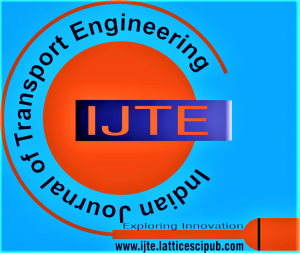Material Availability and Data Access Statement:
- Definition
- Data Access Statement
- Citation of Data and Material Statement
- Material Availability Statement
- Availability of Algorithm and Codes
The Data Access Statement (Data Sharing or Availability Statement) informs readers where to locate research data and how to access it. Authors must ensure that materials, data, code, and protocols are publicly available without credentials, the limitations for access should be disclosed during the article submission process, if any, and include a data access statement when submitting their articles. The data source for the report must be transparent and credible. The data should also be available in a repository for a reasonable time after publication. The authorship will be anonymised within the data during peer review, especially for the Indian Journal of Transport Engineering (IJTE), which utilises a double-anonymised peer review process.
Various repositories support double-anonymisation, providing a link for peer-review access without revealing authorship. If authors fail to comply with the policies after publication, readers are encouraged to contact the journal’s chief editor immediately. This journal takes complaints seriously and strives to resolve them through its editorial process. If complaints are unresolved, the editor will refer to the authors’ funding institution and issue a formal correction. This statement will be attached online to the publication, informing you that the necessary materials to reproduce the findings were unavailable.
Authors should make their research data easily accessible without any unnecessary credentials. When writing, be clear about any restrictions on resource accessibility, especially if a for-profit organisation is involved. The author in charge of correspondence is responsible for ensuring resources are available. A data and material statement should identify where it can be found, such as a public repository. When possible, provide enough information on new compounds for precise replication and use established public repositories for biological materials. Research data and materials should be accessible for a reasonable time after publication. Authorship should be anonymised in the data and material for the double-anonymized peer-review process. The Journal may involve funding institutions if authors refuse to comply with policies and issue a correction statement if necessary, materials are unavailable1.
To ensure proper interpretation, verification, and expansion of research, authors must provide a “Data Availability Statement” before the “References” section. It is recommended to use public or custom repositories instead of including large datasets as supplementary information. As a corresponding author, you must uphold your responsibility to preserve and provide access to data, code, and materials upon publication. Authors ensure that required permissions are obtained, and local regulations are followed for data sharing.
- Datasets: It is necessary to provide information regarding the accessibility of primary and referenced datasets generated and analysed during the study. Accession codes or other relevant unique identifiers are essential if the data is publicly available.
- Clinical Trial Data: It is recommended that articles reporting clinical trial data include data availability statements that adhere to industry best standards2—for example, Arrive guidelines.
- Administrative Data (Data held by governments, local authorities and international organisations): Getting permission from data sources to adhere to any administration, regulatory, and legal frameworks is essential.
- Controlled Data Availability: When writing a data availability statement, explain why data access is limited and provide contact information. Also, describe any data use agreements and limitations. Don’t make strict restrictions; otherwise, the article may be rejected. Be ready to provide a copy of the data use agreement if editors ask.
- Proprietary Data: Authors should obtain agreement with third-party data providers to ensure their dataset(s) will be available for replication and verification after publication. The data availability statement must specify the availability of the dataset, including whether it will be available for a fee.
- Third-Party Data: If third-party data is unavailable, state the limitations in the data availability statement. If requested, provide data for peer review as long as it meets ethical and legal requirements and falls under a data use agreement.
- Identity of the third-party provider: Disclose third-party data provider identity in the data availability statement unless it’s irrelevant or could harm their reputation/commercial interests.
Detailed information about data collection must be included in articles for peer review. Third-party involvement in data processing should be stated if it is beyond the author’s control. More data collection information may result in editors declining to consider the article.
Citation of Data:
When writing an article, it’s essential to include any datasets deposited in repositories as formal citations in the reference list. As Data Cite recommends, having the author(s), title, publisher (repository name), and identifier is essential. Additionally, any dataset identifiers, including DOIs, should be expressed as complete URLs. For example:
Hao, Z., AghaKouchak, A., Nakhjiri, N. & Farahmand, A. Global Integrated Drought Monitoring and Prediction System (GIDMaPS) Data sets. figshare http://dx.doi.org/10.6084/m9.figshare.853801 (2014)
Material Availability Statement:
When writing an article, any limitations on the availability of materials should be clearly stated. Unless otherwise indicated, the corresponding author ensures materials are available. Authors should provide sufficient details about new compounds’ chemical structure, synthesis, and characterisation to enable accurate reproduction. Following the recommended guidelines, it is advisable to use established public repositories for biological materials, such as mutant strains and cell lines, wherever possible:
- EMMA
- Knockout Mouse Project(KOMP)
- European Conditional Mouse Mutagenesis Program(EUCOMM)
- Jackson Laboratory
Availability of Algorithm and Custom Codes:
When submitting an article, authors should provide editors with any algorithm or custom code used to generate the results. If the code is unavailable, editors may reject the article, but they will consider any reasons for not sharing the code. In studies that use custom code or algorithms, there should be a statement about how to access them under the heading “Code Availability”. It should be a separate section after data availability but before references. The code is recommended to be deposited in a repository, such as Zenodo.
References:
